Paleopathology Case Studies
Case 01
Four bones from the single skeleton of a person who was about 30-years-old were recovered from a vandalized Huari cemetery in the Ingenio Valley, Ica, Peru (Huari culture 800-1200 AD). All bones were heavier than normal (a normal femur weighs 350 gms). A radiograph showed a 2/3 reduction of the marrow cavity. A microscopic of the rib is shown with multiple thickening of the cortical area.
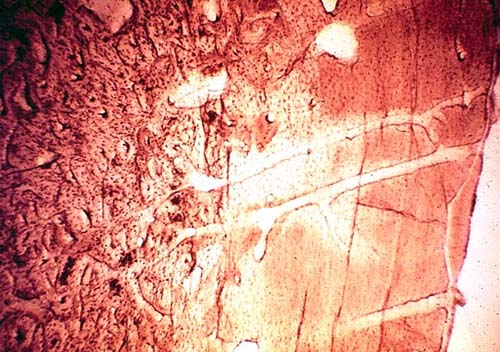

Diagnosis: Case 01 - Primary generalized hyperostosis.
Reference: This case was published in the 1976 MCV Quarterly, 12, 2, pp.49-51.
Case 02
The skull was from a woman around 35-40 years old. It was salvaged from "Falda de Morro" cemetery in Arica, Chile. Visual and X-ray revealed a single, lytic lesion at the junction of the parietal bones with the occipital. It measures 50x45 mm with short, bony spicules. The inner table hole was larger than the outer.
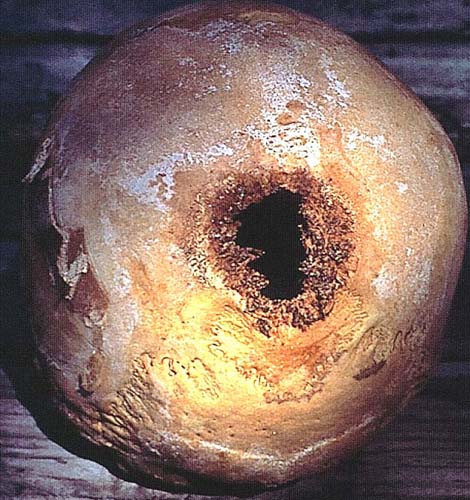
Diagnosis: Case 02 - Unifocal eosinophilic granuloma.
Case 03
This skull is from San Pedro de Atacama, Chile dating from approximately the 3rd century AD. The two photographs are representative of what is a very chronic process that did not involve the internal table of the skull in any way, although it probably limited the use of the eye on that side--due to compression, not direct invasion.
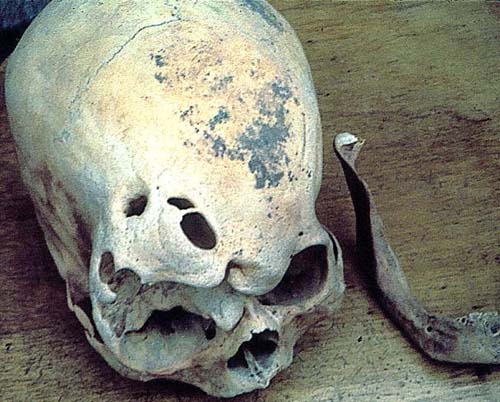
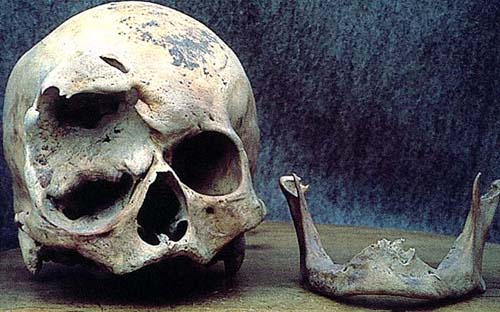
Diagnosis: Case 3--Sinus mucocele.
Case 04
Image A. Mummy of a 56-year-old adult female, buried in the Azapa Valley, Chile, who died around 290 AD. Aside from the usual grave goods associated with mummies in this time period, there were large numbers of tropical bird feathers. On autopsy:
- The right lung on the lateral surface was firmly adherent to the costal pleura at the level of the 3-5th ribs.
- Separation of the adhesion revealed a large cavity 95x70x55mm (slide 1). The cavity contained a blackish granular material.
- Right tracheobronchial lymph nodes were the size of marbles.
- Three sets of enlarged mediastinal nodes were noted.
- The right kidney was thickened and irregular in shape when compared to the left.
- Histological sections of the right lung cavity wall revealed numerous red blood cells and yeast-like organisms 6-12 microns.
Image B. EM studies revealed the organisms seen in image B in the form of a "ship's wheel".
IMAGE A
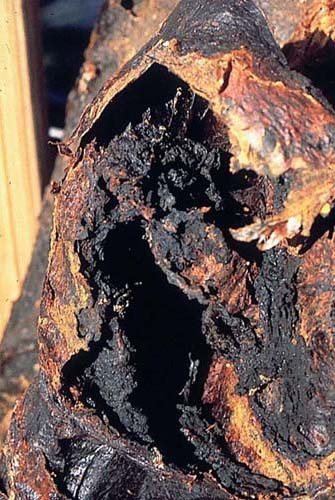
IMAGE B
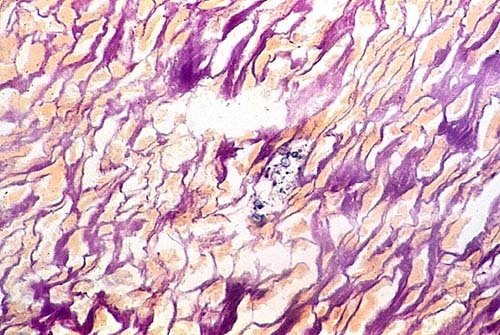
Diagnosis: Case 4 - South American blastomycosis.
Case 05
A mummy bundle with the skeleton of a 45-year-old female from 800 AD was salvaged near Arica, Chile. At autopsy, nine bones had gross evidence of pathology: the skull, the right and left innominate, the right femur, sacrum, the eighth thoracic vertebra, the fourth and fifth lumbar vertebrae, and the sternum.
The skull had three lesions of the parietal bones near the sagittal suture. The largest was a lytic lesion that began in the diploe and perforated the inner and outer tables equally, leaving a ragged opening 35x30 mm. To the right of this opening was a nonperforating lesion 17x16 mm and to the left a smaller nonperforating lesion 15x15 mm. The nonperforating lesions were seen as a roughening and incipient crumbling of the outer table. Radiographically, the nonperforating lesions were considered to be sclerotic lesions. There was a third non-perforating lesion about 10x10 mm in the central portion of the occipital bone.
Both innominate bones were extensively involved in the disease, seen in second image. The right femur had a lytic lesion at the proximal end which involved the neck. There were three lesions of the vertebrae. The entire eighth thoracic body was destroyed. The fourth and fifth lumbar each showed a small incipient lesion in the body. There was a small lytic lesion in the sternum at the level of costal notch II.
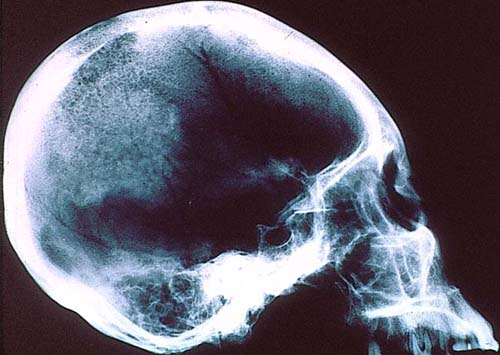
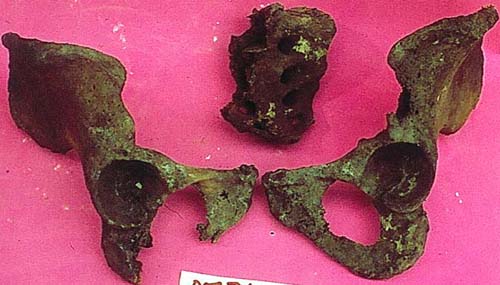
Diagnosis: Case 5 - Metastatic Tumor, most likely from a primary of the breast.
Reference: Bulletin of the New York Academy of Medicine, 56, 585-587, 1980
Case 06
A male mummy, over 40 years old, from 2800 BP was autopsied. On opening the intact thoracic cavity, a hard, stony structure was found in the mediastinum. It measured 40x18 mm, was greenish in color and was partially covered by the pleura. Microscopically, there was no reaction around the structure.
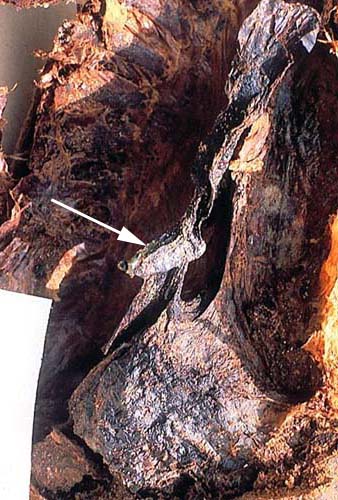
Diagnosis: Case 06 - Projectile Point still in the mediastinum. The skin was completely healed. The time of the injury was long before death.
Case 07
Male mummy (17-19 years old) dating about 300 AD. Review of the organs showed the lungs with emphysematous changes. The only other abnormality is in the kidneys. Cross-section is shown in the picture. The appearance is similar in both kidneys.
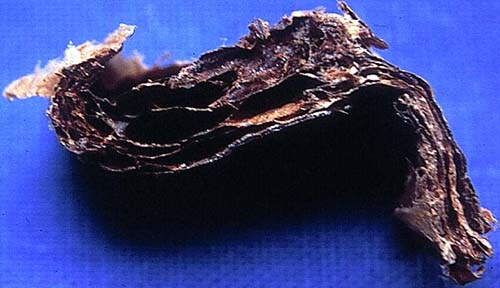
Diagnosis: Case 07 - Polycystic Kidney Disease
The kidney showed gross and microscopic features of this disease.
Case 08
This mummy of an 8-year-old male dates from 300 AD. A review of the internal organs shows the following findings:
-
the heart (enclosed picture)
- the lung (pneumonia) and the liver (multiple abscesses)
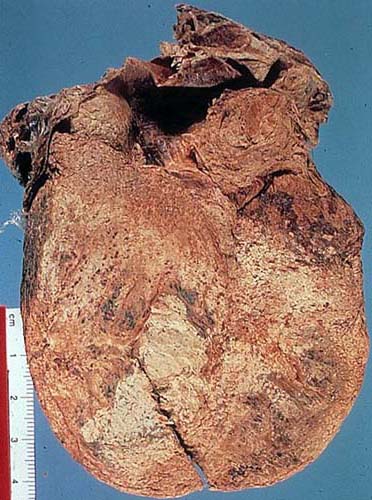
Diagnosis: Case 08 - Cardiomegaly and fibrous and fibrinous pericarditis, a complication of a fatal pneumonia.
Case 09
This skull is from a 45-50-year-old woman from the Maitas-Chiribaya culture who died around 1000 AD. The cemetery was in a ceremonial site and numerous dogs were found in the excavation, some also with ceremonial burials. The lesion seen in the slide is a solitary bone lesion involving the nose, right eye, left frontal sinus, right maxillary sinus and posterior palate.
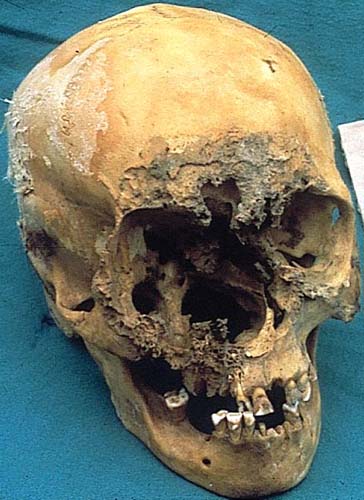
Diagnosis: Case 09 - Chronic leishmaniasis with a superimposed infection.
Case 10
Adult with skin lesions and skull with "saber shin" tibias from an Atacameña, Chilean mummy dating around 290 AD.
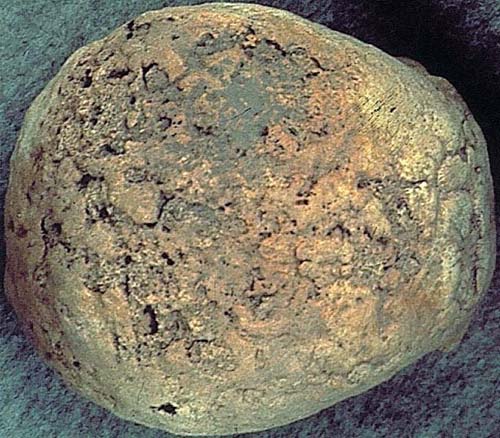
Diagnosis: Case 10 - Trepanematosis.
Case 11
A newborn child from a cemetary in Ica, Peru shows occipital bone lesions and similar lesions in the parietal bones.
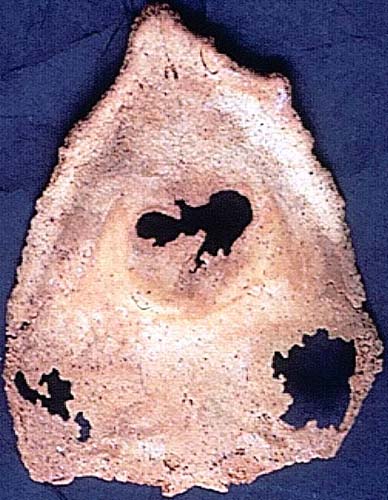
Diagnosis: Case 11--Lückenschädel Syndrome.
Case 12
Mummy liver section from a 5-year-old Inca child. On gross examination, the liver was enlarged and the microscopic lesions seen were present throughout the liver parenchyma.
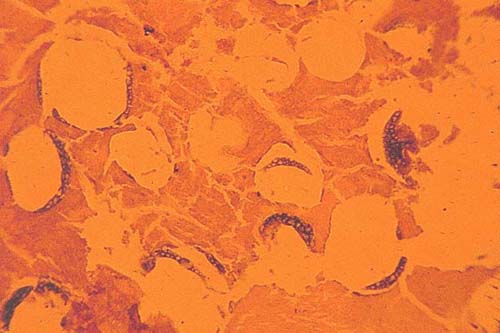
Diagnosis: Case 12 - Echinococcosis (E. multilocularis)
Multilocular cysts are found in this species with the pox, and possibly puma, as the definitive hosts.
Case 13
Male, age 25 dating from 250 AD. The external examination showed a circular wound in the neck into the trachea and a large, 20 cm wound in the left abdomen with the left hand holding loops of the intestine. The head had been cut off and was probably taken as a trophy. Organs were present and normal except for one kidney.
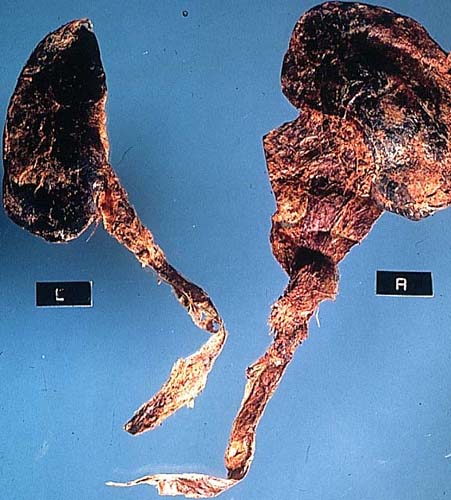
Diagnosis: Case 13 - Hydronephrosis of right kidney caused by a calculus lodged in the right ureter.
Case 14
Mummy of a 14-year-old boy. There is a mass that measures 4x4x2 cm high 6 cm below the axilla, on the right side of the nipple. Included is an image of a microscopic section from the tumor mass--H&E.
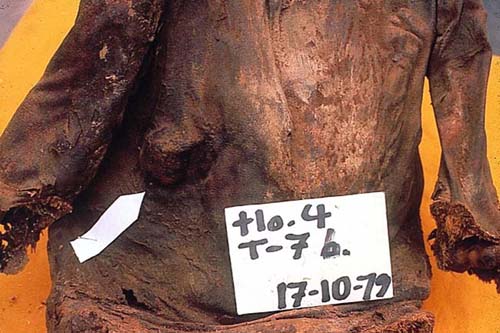
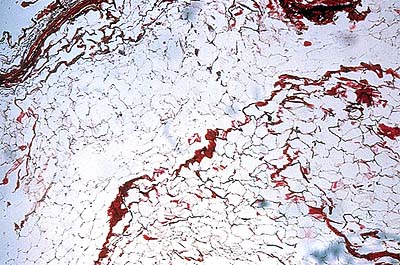
Diagnosis: Case 14--Lipoma.
Case 15
Mummy of a 40-year-old man of the Huari culture. The picture shows the base of the skull.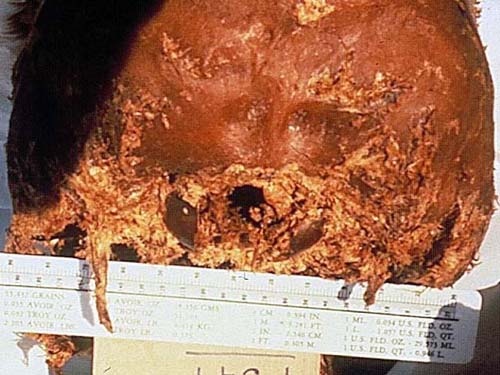
Diagnosis: Case 15 - Elongated styloid process (Eagle's Syndrome).
Reference: [No author given] (1980, January). Elongated styloid process in a Pre-Columbian Peruvian. Journal of Dental Research, p. 79.
Case 16
This picture shows the gross examination of the thoracic cavity of an 11-year-old male mummy from 350 AD.
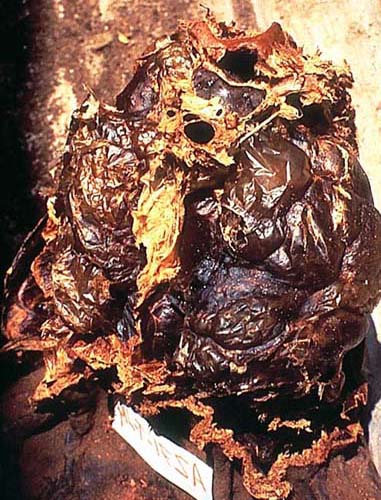
Diagnosis: Case 16 - Bilateral emphysema.
Case 17
Skin biopsy from a woman approximately 40-years-old from 350 AD. The section was taken from her forearm. It represents one of numerous 1-2 mm papular, rough-surfaced, elevated lesions. For orientation, the epidermis is missing, but the papillary and reticular dermis may be distinguished.
Submitted by Dr. H. Sasken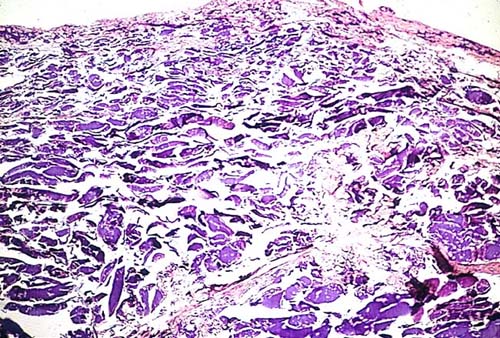
Diagnosis: Case 17 - Systemic vasculitis (trepanematosis).
Case 18
Right and left humerus, ulna and radius of a 22-24-year-old male from 350 AD.
Measurements (mm)
Right Left
Humerus 305 235
Ulna 244 268
Radius 199 252
The glenoid cavity of the left scapula was eroded and its shape deformed. The soft tissues appeared normal.
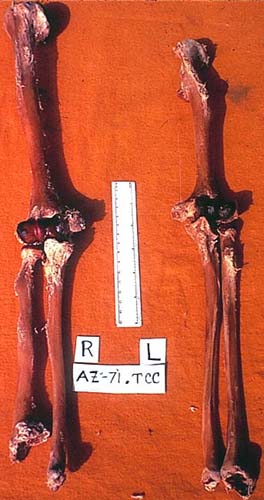
Diagnosis: Case 18 - Possible Accident
X-ray studies suggest that the lesion of the left humerus and right forearm are related and caused by an accident. The left humerus is a fracture resulting in remodeling of the bone with subsequent loss of scapula joint contact and/or formation of a new articulation. The right forearm can be classified as a reverse Madelung deformity.
Case 19
The left humerus was the only material recovered from this adult. The length is 161 mm. The epiphysis are well-fused. The proximal shaft is thickened and robust with enlarged greater and lesser tubercles and an extremely prominent deltoid tuberosity. The olecranon fossa is small, as are the radial and coronoid fossae. The medial epicondyle is exaggerated, giving a flared appearance distally.
Submitted by Dr. James M. Tenney
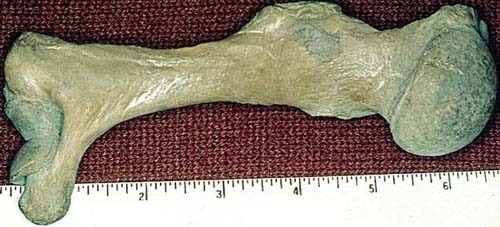
Diagnosis: Case 19 - Achondroplastic dwarf.
Source of material: Lowie Museum of Anthropology, Berkeley, CA, Accession No. 12-6616)
References:
Hoffman, J. M. (1976). Contributions of the University of California Archeological Research Facility, 30, pp. 65-119.
Case 20
This low-power photomicrograph is of breast tissue from a frozen mummy of a 42-year-old Eskimo woman who died in northern Alaska approximately 500 years ago. Both breasts were prominent on gross examination.
Submitted by Dr. Michael Zimmerman
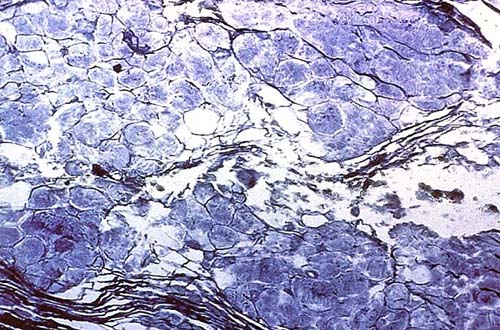
Diagnosis: Case 20 - Pregnant breast.
Case 21
Autopsy of an ancient cadaver from the Han Dynasty (207 BC-220 AD)--the tomb was found in Hunan Province. Above are relics found in the tomb. Below is a section of the liver.
Submitted by Dr. Longxiang Peng
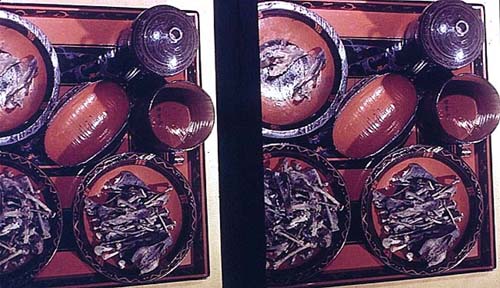

Diagnosis: Case 21 - Schistosome
Section of the liver shows a nodule containing several schistosome eggs. Among the valuable relics there are many lacquers. Shown is some of the dinner set.
Case 22
Autopsy from a frozen mummy; microscopic section of the lung.
Submitted by Dr. Michael R. Zimmerman
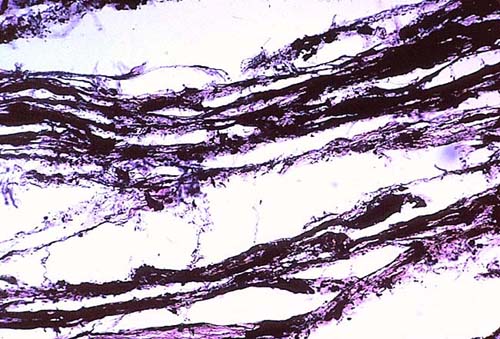
Diagnosis: Case 22 - Anthracosis and fibrosis.
Case 23
H&E section of one of eight skin lesions on the lower extremities of an frozen Incan mummy (9-year-old) found at high altitude in the Andes.
Submitted by Patrick Horne
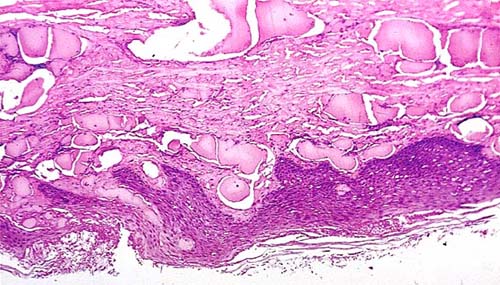
Diagnosis: Case 23 - Microscopic section showed a rare childhood tumor of skin--angiokeratoma circumscriptum.
Reference: (1984) Bulletin NY Academy of Medicine, 60, 9, pp. 925-931
Case 24
Adult male mummy from the Cabuza culture (Northern Chile about 450 AD). This picture shows the opened chest with the right lung exposed in more detail than the left. The autopsy findings included right ventricular dilatation and massive gastric dilatation.
Submitted by Dr. Authur C. Aufderheide
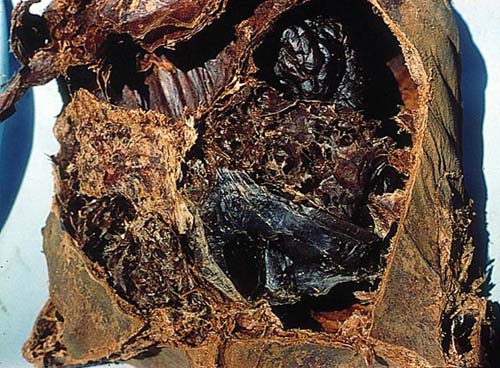
Diagnosis: Case 24 - Diffuse bilateral bullows emphysema.
Case 25
Infant male mummy heart from the Anasazi culture (Canyon de Chelly, northern Arizona, about 600 AD ± 95 years). The illustration shows the outflow tract of the left ventricle, the interventricular septum, and valvular cusps. Other autopsy findings included cardiomegaly and peripheral edema, including ascites.
Submitted by Dr. Abel L. Robertson
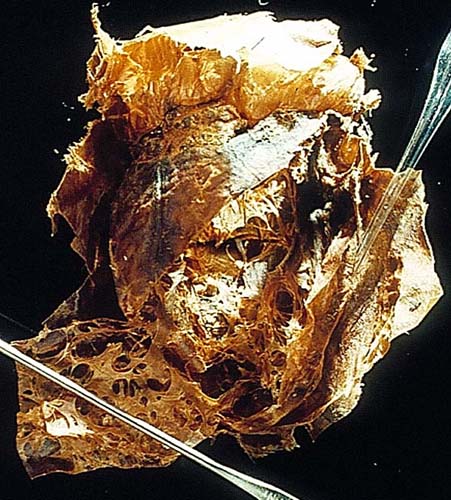
Diagnosis: Case 25 - Common atrial ventricular canal.
Case 26
Picture shows the posterior surface of two intentionally deformed skulls excavated from Pre-Columbian sites in Northern Chile.
Submitted by Peter C. Gerszten
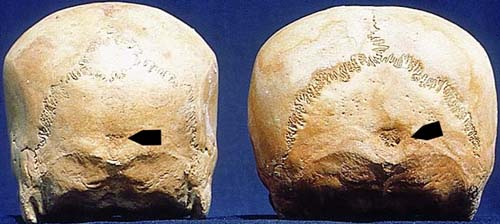
Diagnosis: Case 26 - Necrosis of the occipital bones resulting from the pressure of a head deforming apparatus. The left skull also has an intercalary bone (wormian bone).
Case 27
A skin lesion of an Egyptian mummy taken from the Marro Collection, Turin, Italy (Cat. No. 61). The lesion is from the neck, and it is presented as a raised, hard, roundish mass, brown in color, (0.7 cm in diameter).
Submitted by Dr. Ezio Fulcheri
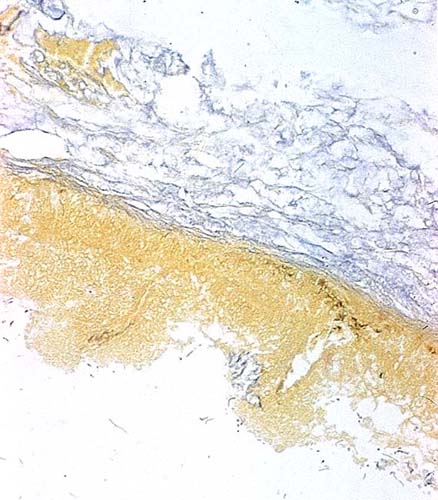
Diagnosis: Case 27 - Verrucous lesion.
Case 28
Tibias of a Roman soldier (50-60-years old) from Gerulata I burial ground dated from the 3rd-4th century AC (from the Slovak National Museum, Bratislava).
Submitted by Dr. Václav Smrcka, Dedická
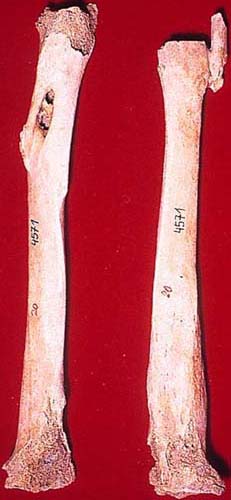
Diagnosis: Case 28 - After fractures of the distal third of each tibia, the slide shows a callous formation on the right with union of the fibula. On the left side an osteomyelitis is shown.
Case 29
Right radius and ulna with proximal fusion from protohistoric adult Indian (Chumash), Santa Rosa Island, CA. The union starts at the radial head and extends distally for a distance of 4.8 cm resulting in 90 degree pronation of the distal ends.
Submitted by Dr. James M. Tenney

Diagnosis: Case 29 - Congenital radio-ulnar synostosis.
Reference: Edmonson, A. S., & Crenshaw, A. H. (1980). Campbell's operative orthopaedics. St. Louis, MO: C. V. Mosby.
Case 30
The lower portion of the tibias from a Pre-Columbian mummy from Northern Chile.
Submitted by Dr. Marvin J. Allison
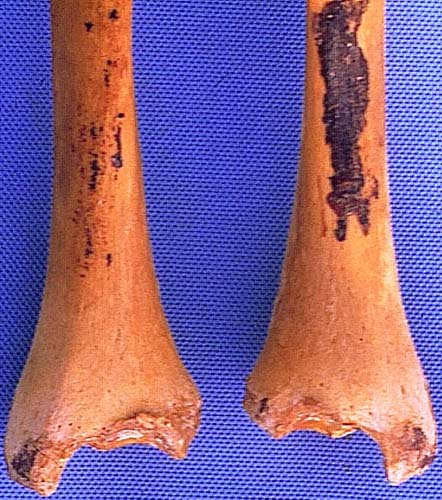
Diagnosis: Case 30 - Squatting facets. Flexing the lower extremities for extended periods of time produces characteristic impressions on the bones of the joints.
Reference: Ubelaker, D. H. (1978). Human skeletal remains. Illinois: Alidine.
Case 31
The slide shows the opened gallbladder of an adult, female, Pre-Columbian mummy from Northern Chile.
Submitted by Dr. Marvin J. Allison
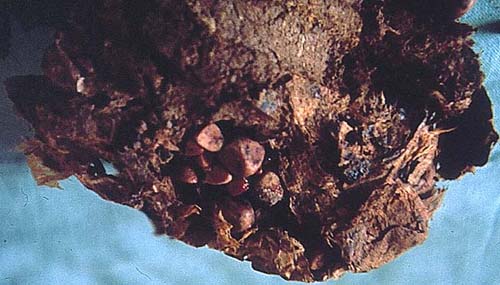
Diagnosis: Case 31 - Cholecystitis and cholelithiasis.
Reference: [author not given]. (1978, February). Cholelithiasis and cholecystitis in Pre-Columbian Chileans. American Journal of Physical Anthropology, 48, 2, pp. 209-212.
Case 32
The external auditory canal from a Pre-Columbian mummy (male adult) from Northern Chile (coast).
Submitted by Peter Carlos Gerszten
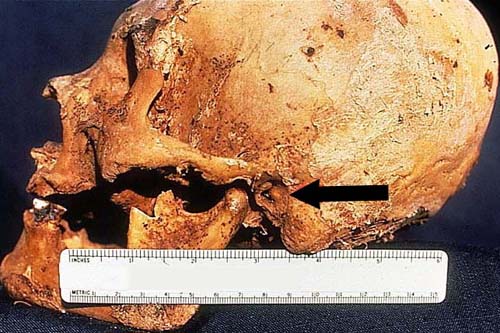
Diagnosis: Case 32 - Exostosis.
Reference: Greg, J. B., & Bass, W. M. (1970). Exostoses in the external auditory canals. Annals of Otology, Rhinology and Laryngology, 79, 4, pp. 834-839.
Case 33
Cross-section of the midshaft of a femur of an Egyptian male, circa 36 BC to 400 AD (the Roman period of Egypt).
Submitted by Megan Cook and C. Anderson, MD
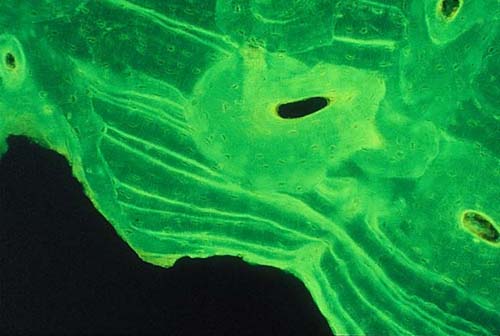
Diagnosis: Case 33 - Tetracycline labeling
The slide shows tetracycline labeling similar to that of tetracycline labeled patients under metabolic bone disease investigations. It is postulated that the tetracycline was present in the stored grain.
Case 34
Radiograph of the pelvis from a 50-year-old female who was a member of the Maitas Chiribaya culture circa AD 1200. Other osteological findings included lytic lesion in the body of C6 and C7, and an abscess in the posterior intercondyloid fossa of her left tibia.
Submitted by Bernardo Arriaza
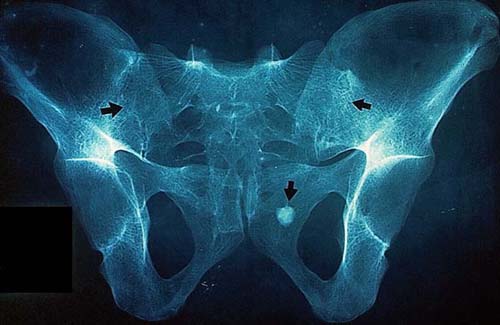
Diagnosis: Case 34 - Complete bilateral sacro-iliac ankylosis and tumor in the diploe of the left pubic corpus. This is probably a case of seronegative spondyloarthropathy such as ankylosing spondylitis. Incidental finding--a bladder calculus.
Case 35
Mummy of a priest from the early XVII century entombed in the basement of the Iglesia del Carmen Church in Mexico City.
Submitted by Dr. Marvin J. Allison

Diagnosis: Case 35 - Smallpox.
Reference: Medicine in Mexico, by Gordon Schendel, University of Texas, 1968
Case 36
The skull is from a Woodland Indian from the XVI century. It was found in the Tennessee-Virginia border. Although the skull was damaged, the main lesion is clearly visible.
Submitted by Dr. Marvin J. Allison
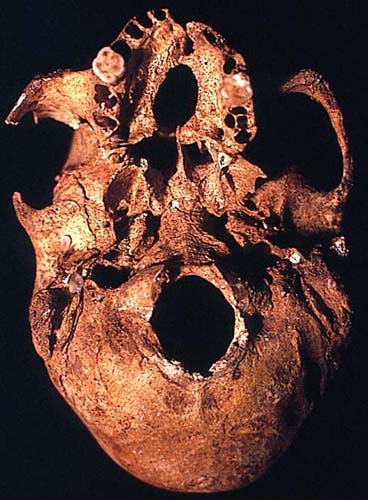
Diagnosis: Case 36 - Posterior palatal cyst.
Reference: Gregg, J. B., Allison, M. J., Clifford, S., Gerszten, E., & Klippel, W. E. (1983). [article title not given]. Journal of the Plains Anthropological Society, 28, p. 293.
Case 37
The skull is from an adult male mummy found in the Valle de Lluta, northern Chile, from the Gentilar culture that flourished between 1200 and 1470 AD.
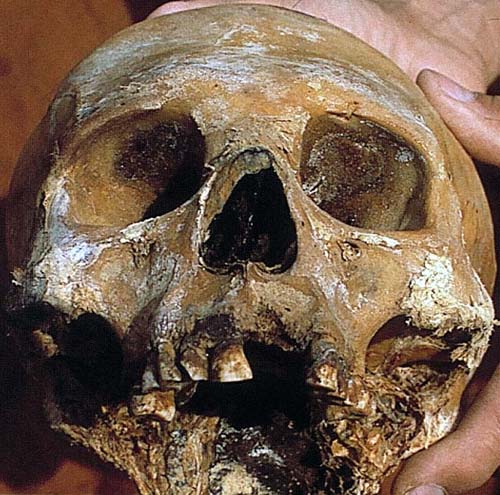
Diagnosis: Case 37 - Criba orbitalia.
Case 38
A section of the lung from a 3-year-old female, Pre-Columbian mummy from northern Chile.
Submitted by Dr. Jerrold L. Abraham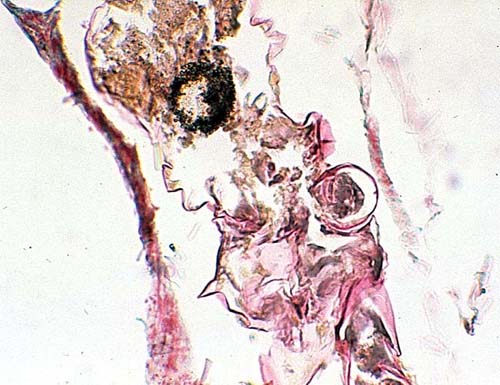
Diagnosis: Case 38 - Lung infested by mites.
Case 39
Diagnostic pathology is aided by knowing the society and environment in which the patient lives. One of the greatest difficulties in paleopathology diagnostics is the general lack of a clinical history, or lack of a thorough understanding of the times and the society in which the person lived. On occasion, we do have diagnostic aids that are found in the grave along with the body. One such aid was this kit containing items used to perform a certain ritual act. The kit is from the San Miguel coastal people of northern Chile. It dates from about 1000 AD.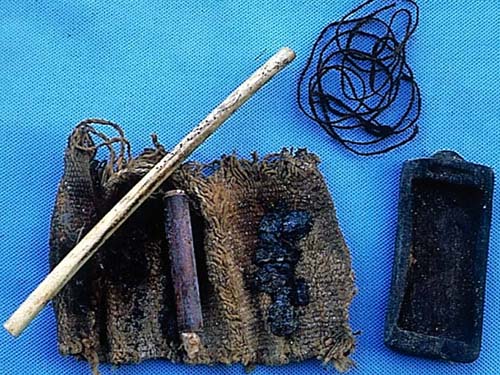
Diagnosis: Case 39 - Hallucinogenic Kit
The use of hallucinogens in South American folk medicine goes back thousands of years. Three major types are still in use today: 1) the San Pedro cactus which is used as a source of mescaline 2) Ayahuasca (Banisteriopsis caapi), a jungle vine which is the source of banisterine 3) Wirca (Piptadenia colubrina), a large, flat seed.
San Pedro is used as a tea in northern Peru. Ayahuasca, as a tea in the Amazon, and Wirca as a powder in southern Peru, Bolivia and Chile. For many years in some graves in northern Chile, archeologists were finding small, wooden trays. Some were plain. Others were carved and decorated with colored stones. It was thought that the trays were used to crush tobacco to make snuff. In recent years, however, complete kits were found along with the seed that was crushed on the tray using a bone spatula.
The powder from the crushed seed would have been brushed into a small pile and aspirated through a bird bone into the nasal mucosa. Powerful hallucinations would have been produced in about twenty minutes. The image shows a kit that is about 1000-years-old. It consists of a wooden tray, seeds of Wirca, a small tube of powder with a cotton stopper, and a bird bone inhaler. All of this would have been wrapped in a cloth and tied with a string. Such kits were generally found in the graves of elderly males.
Case 40
A pelvis (above) and a rib (below) of a man (about 32-years-old) from the Diaguita culture that inhabited the area of Chile at the level of La Sirena, spilling over into what is present day Argentina. Their period is approximately 1200 AD-500 BP. They were shepherds, fishermen and farmers of squash, beans and corn.
Submitted by Maria Rosado
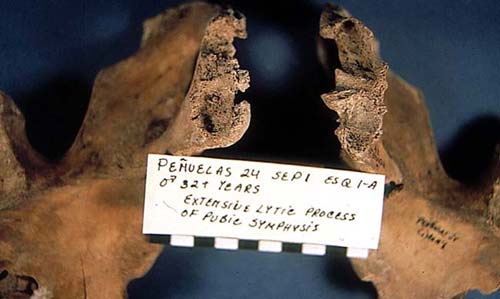
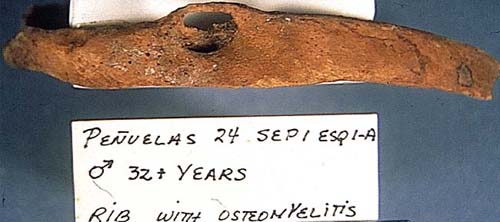
Diagnosis: Case 40--Post-traumatic osteolitis.
Case 41
This specimen is from Tal-Liedna Road in Malta. It is one of the Punic skeletal remains from the 3rd century BC. The specimen is from a young female. The anterior view of the right shoulder joint is shown.
Submitted by S. Ramaswamy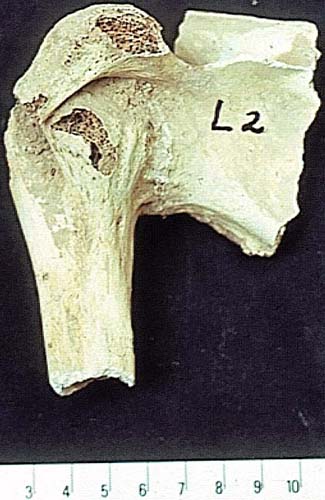
Diagnosis: Case 41- Chronic pyogenic osteomyelitis with ankylosis.
Case 42
Two skulls from females approximately 40-years-old; dated 500 AD. Both skulls show severe destruction of bone in the nasal/orbital maxillary area with peripheral extension.
Submitted by Bernardo Arriaza
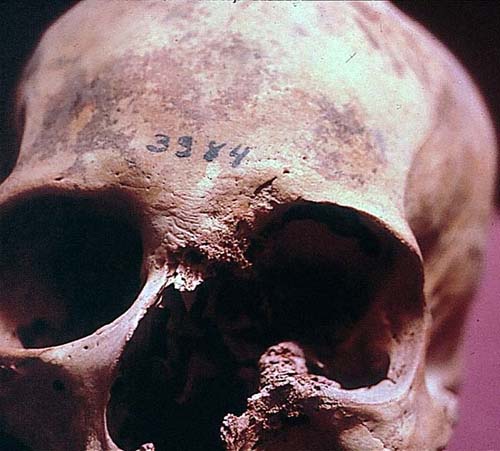
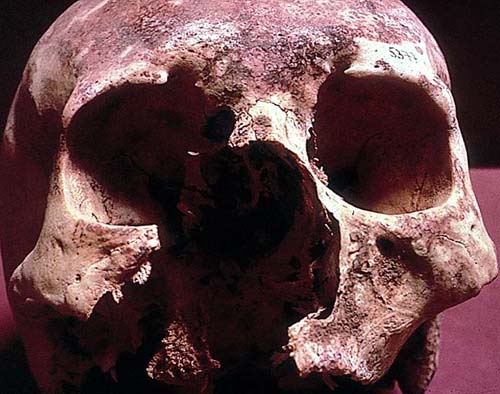
Diagnosis: Case 42 - Infected mucocutaneous leishmaniasis.
Case 43
This bronze figurine from the Cuzco area depicts a medical problem. There was a late Inca custom that, instead of sacrificing a person, a bronze or ceramic effigy was buried with an important man who'd died.
Submitted by Dr. Marvin J. Allison

Diagnosis: Case 43 - Potts disease.
Case 44
This specimen is from Oman.
Submitted by Dr. Ezio Fulcheri

Diagnosis: Case 44 - Bone Fracture with diastasis and pseudo-arthrosis.
Associated with mild osteomyelitis in the proximal fragment. This pathology is frequently seen as a complication of severe bone fractures.
Case 45
This specimen is from a tamarack bog excavation in Minnesota. The age of this specimen is approximately 8,000 years BP. It is the right mandible of an adult bison (Bison bison).
Submitted by Dr. Standley E. Lewis
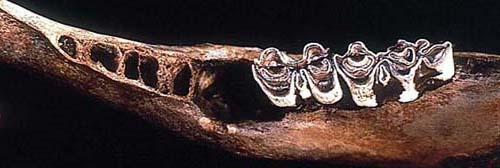
Diagnosis: Case 45 - Actinomyces bovis. The infected bison jaw appears to represent a bacterial infection, probably caused by the organism Actinomyces bovis.
Case 46
Excavation from the island of Guam, Latte phase AD 800-1000. Female: age 40. Images shows bones from 2 thumbs and 5 finger distal phalanges from distal ends. In 2 of the specimens, little remains but the proximal end plate. Four of the proximal end plates appear normal, three are flared and cupped.
Submitted by Bernardo Arriaza and Diane Grembly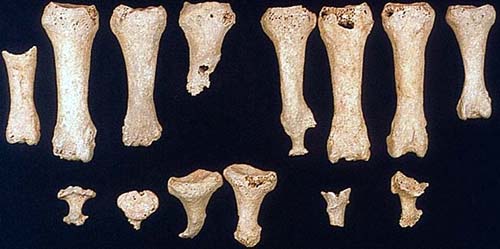
Diagnosis: Case 46 - Leprosy.
Case 47
Skull from the San Miguel Culture of northern Chile that dates from 1000 AD. There is a soft tissue nodule in the nasal cavity.
Submitted by Dr. Marvin J. Allison
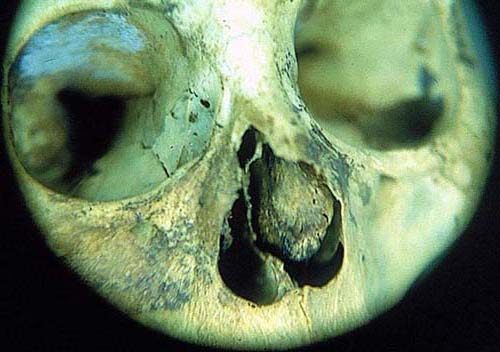
Diagnosis: Case 47 - Nasal polyp.
Case 48
This specimen is a frontal bone found in a cave in Benidoleig, Alicante, Spain from the eneolitic period (2,000 BC). The bone is from a male 20-25-years-old. The external surface shows a circular opening. The image is from the internal surface showing a loss of bone tissue.
Submitted by Dr. Domingo Campillo
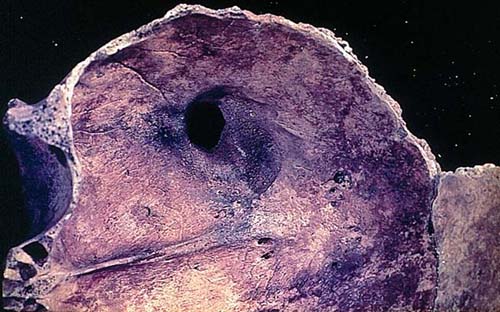
Diagnosis: Case 48 - Lesion is the result of an arterial venous endocranial aneurysm of probable meningeal origin.
Case 49
Sacrum of a young Egyptian male about 17 years old from the pre-dynastic period.
Submitted by Dr. Ezio Fulcher
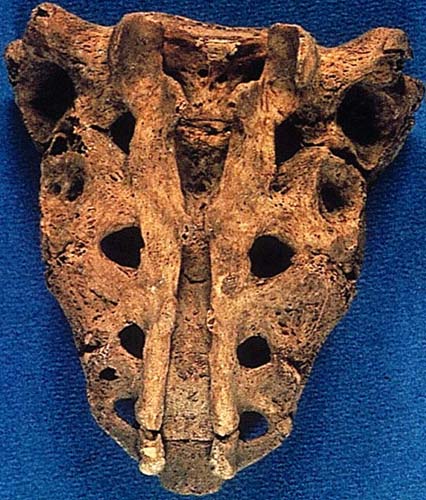
Diagnosis: Case 49 - Incomplete bone fusion of all segments of the sacrum compatible with spina bifida occulta.
Case 50
Proximal surface of the right and left third metatarsals and distal surface of right and left third cuneiforms showing a symmetric and bilateral lesion at the plantar end of each bone. The trabecular bone is exposed. The bones correspond to a male 25-30 years of age, Havikuh Pueblo Indian.
Submitted by Dr. Bernardo Arriaza
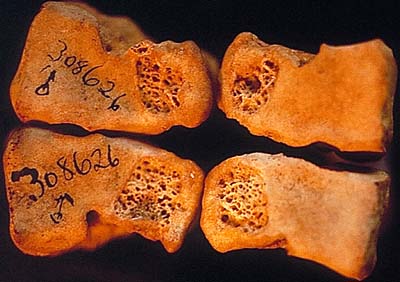
Diagnosis: Case 50 - The plantar lesions appear to be idiopathic microtrauma due to walking barefoot in rough terrains.
Case 51
This section of vertebral bone is from the frozen body of a 45-year-old Eskimo woman who was crushed by ice in Barrow, Alaska, 500 years ago.
Submitted by Dr. Michael R. Zimmerman
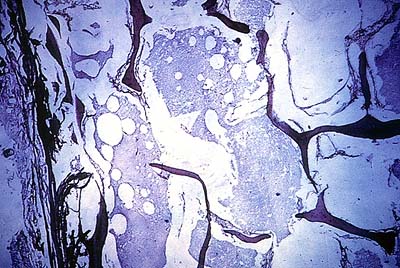
Diagnosis: Case 51 - Osteoporosis. The bone was severely demineralized and could easily be cut with a scapel.
Case 52
The picture shows the skull of a 4-year-old from the middle period (ca. 2500 BC to 500 AD) of Central California.
Submitted by Susan C. Antón
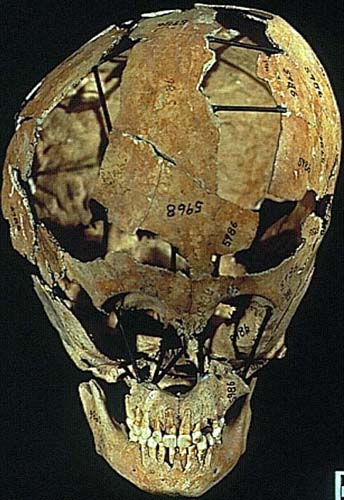
Diagnosis: Case 52 - Anterior view of the skull showing hydrocephalus.
Case 53
Specimen from the Monterey Bay area of Central California dates from 2200-4900 BP. The lesion is a rough, oval-shaped defect involving the lateral cortex of the mastoid process of the left temporal bone, extending from the mastoid tip to just cephalad to the floor of the external auditory canal.
Submitted by Lorna C. Pierce, PhD
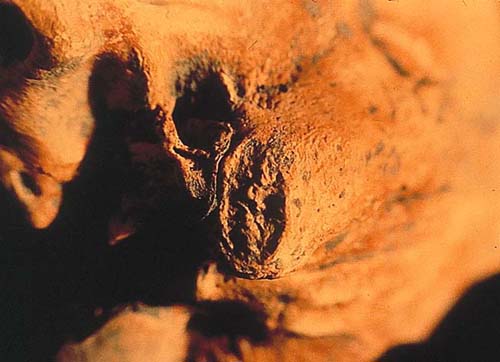
Diagnosis: Case 53 - Acute otitis media complicated by mastoiditis.
Reference: Loveland, C. J., Pierce, L. C., Gregg, J. B. Ancient temporal bone osteopathology, San Jose State University, San Jose, CA, pp. 95192-0113
Case 54
Skull of a young male from Neolithic Denmark (7000 BP).
Submitted by Dr. S. Ry Andersen
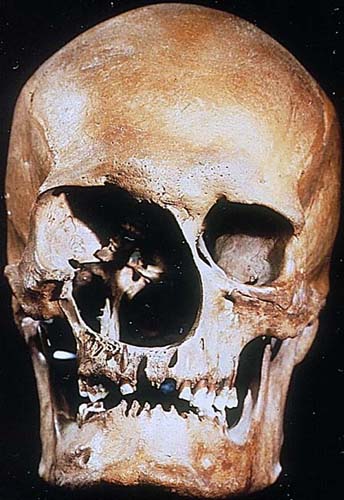
Diagnosis: Case 54 - Benign Tumor of Nasal Cavity.
Reference: Brothwell, D., and Sandison, A. T. (1967). Diseases in Antiquity. Springfield, IL: Charles C. Thomas, p. 329.
Case 55
The posterior cranial vault region of an adult male Mayan from northern Belize, dating from the Postclassical period (circa 1300 AD).
Submitted by Dr. Christine D. White
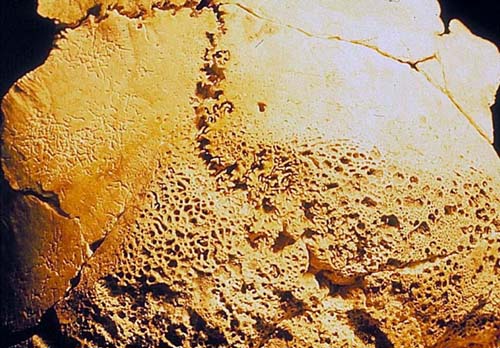
Diagnosis: Case 55 - Active Porotic Hyperostosis caused by ongoing iron deficiency anemia.
Case 56
This material was excavated at the Carrier Mills site in southern Ilinois (dated 7000-5000 BP). The material consists of a portion of dorsal lumbar spine composed of five vertebrae and associated intervertebral disc. On cut surface, the intervertebral discs appear preserved and calcified.
Submitted by Dr. Kenneth P. H. Pritzker and Dr. Bruce Rothschild
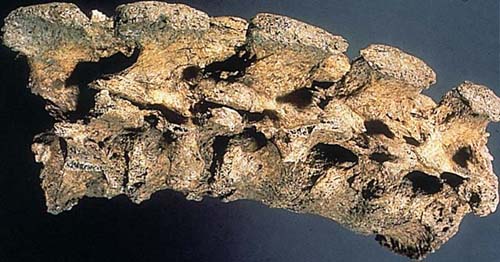
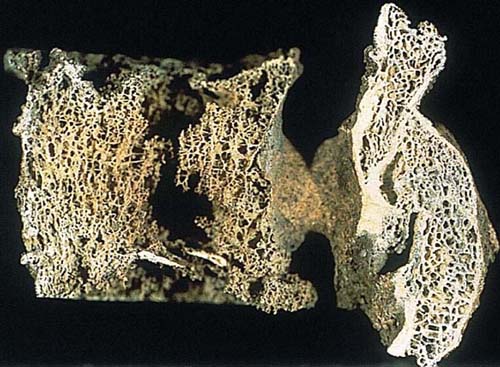
Diagnosis: Case 56 - Ankylosing spondylitis with disc calcifications.
Case 57
An egg found in a latrine in the English settlement at Ferryland, near Saint Johns, Newfoundland, Canada. This settlement was founded by George Calvert, 1st Lord of Baltimore, in 1621.
Submitted by Patrick Horne
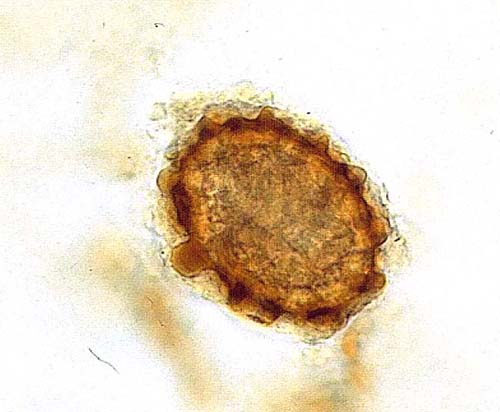
Diagnosis: Case 57 - Ascaris egg.
Case 58
Hyoid bone with 5 mm round lesion on external surface, with smooth borders and slight bony build-up around a rim of lesion and thin bony floor at base of lesion. This bone comes from a young adult caucasian male, 20-21 years of age, from a 13th century Frankish cemetery in Corinth Greece.
Submitted by Ethne Barnes, PhD
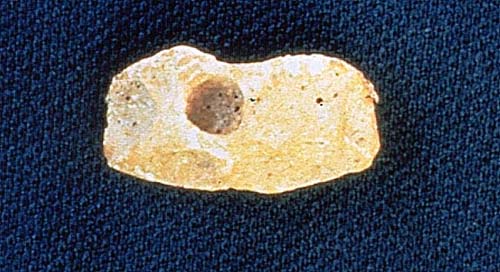
Diagnosis: Case 58 - Thyroglossal cyst.
Reference: Moore, K. L. (1985). Clinical oriented anatomy. (2nd ed.). Baltimore: Williams & Wilkens, pp. 1026, 1029, 1066.
Case 59
Vertebrae found in the archeological site Kon-Kon, Rio Chillón, Lima, Perú (1100-1400 AD). The image shows two dorsal vertebrae with synostosis. In the left lateral side of the body, there is a lesion without alteration of the vertebral architecture.
Submitted by Dr. Carlos E. Ponce García
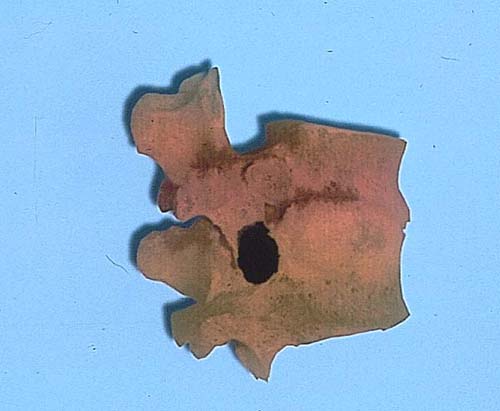
Diagnosis: Case 59 - Vertebral abscess.
Case 60
EM image from the chest organ of a northern Chilean mummy. The mummy was a 12-year-old female from the Cabuza culture (300-600 AD).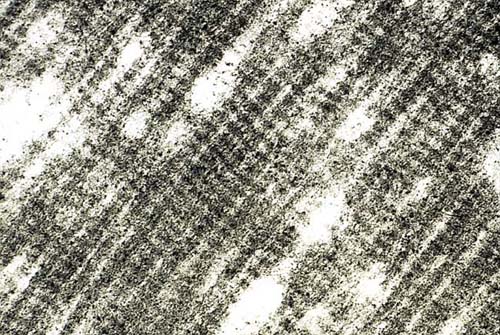
Diagnosis: Case 60 - EM showing bands of the myocardium in normal myocardium.
Case 61
Paleopathology Case 61
The archeological specimen is from a young man 23-25 years of age, dated 200 BP. The lesion is on the seventh rib, right, size 11x8x7 cm. It shows a growth of bone forming a "sun burst effect" with areas of bone destruction.
Submitted by Milagros Macías López
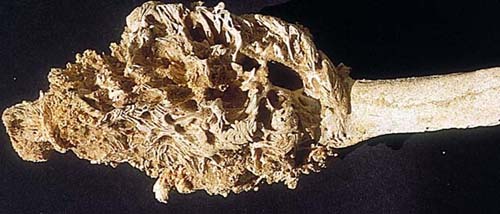
Diagnosis: Case 61 - Osteogenic sarcoma.
Case 62
The X-ray is from a 16-year-old female, Cabuza culture, Northern Chile (350-500 AD).

Diagnosis: Case 62 - Severe chronic osteomyelitis with a large sequestrum of the humerus.
Case 63
Metatarsal bone of bovine, found in a IV Century Roman area in Varea (Logroño, La Rioja) of northern Spain.
Submitted by Dr. Julio Martinez Flores
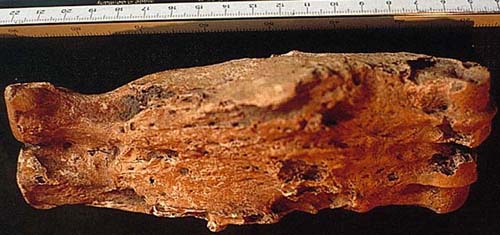
Diagnosis: Case 63--Tuberculosis of bovine metatarsal bone.
Case 64
Gross (above) and X-ray (below) from the heart of a 3-year-old female from the Cabuza culture (350 AD).The material injected was Hypaque 60 (meglumine diatrizoate 60%).
Submitted by Dr. Enrique Gerszten, Dr. Marvin J. Allison and Dr. James Messmer
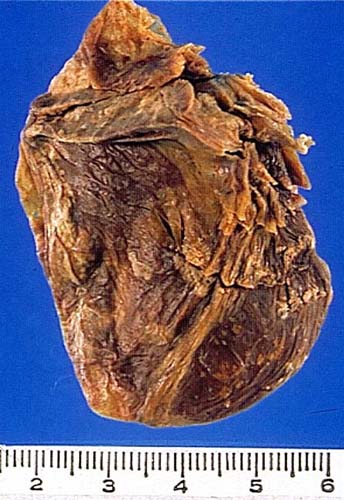
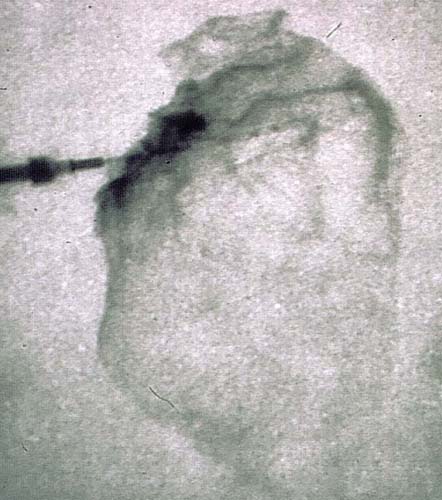
Diagnosis: Case 64 - Normal coronary arteries.
Case 65
A 50-year-old man from the Nazca culture (southern Peru) from ± 900 AD (Lineal Tomography).
Submitted by Dr. Guido P. Lombardi
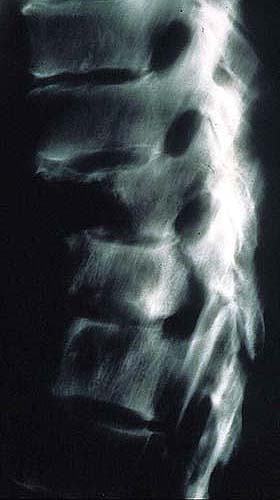
Diagnosis: Case 65 - Metastatic tumor involving T10-12. Osteolytic lesions, probably from a metastatic tumor, are shown involving the vertebral bodies of the T10-T12 segment.
Case 66
Vertebral column from a 20-year-old Peruvian man who died 1150 AD. Examination of the lumbar spine and sacrum revealed a severe retolisthesis of the lumbosacral junction with severe compression fractures of the L4 and L5 vertebral bodies. In addition, there was a loss of the normal lumbar lordosis. Radiographic examination revealed a complete bony fusion of the L3-S1 vertebral bodies. This was confirmed by computed tomography.
Submitted by Dr. Peter Gerszten
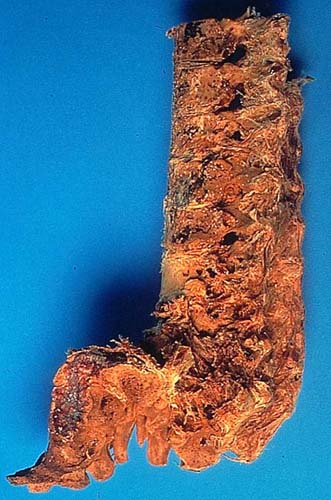
Diagnosis: Case 66 - Traumatic injury.
Case 67
Male 60-65-years-old from 12-13th century in Italy. Specimen is the elbow area of the left arm.
Submitted by E. Fulcheri, M. Reto, and R. Boano
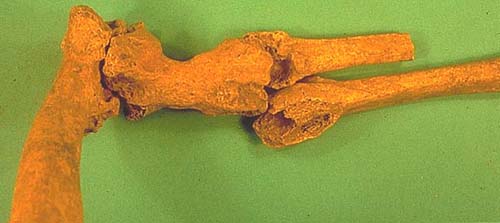
Diagnosis: Case 67 - Fractures of the proximal metaphyseal part of the left radius and ulna together with fracture of the elbow joint.
Case 68
The image is from a breast section stained with fast red against antibody to MAM6. It is from the mummy of an 18-year-old girl belonging to the Maitas culture who died about 1000 years ago. She was our youngest pregnant female and had delivered one twin, but bled to death before the delivery of the second baby. She held the umbilical cord of the first baby in her hand.
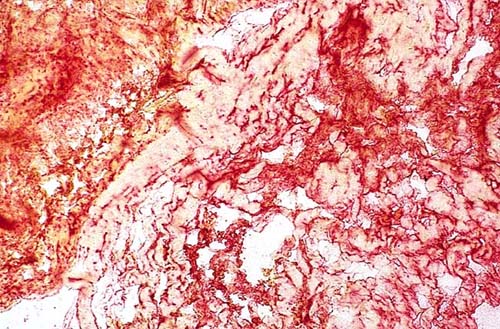
Diagnosis: Case 68 - Reactive human milk fat globule protein antigen (1000 years old).
Case 69
Both patellas belong to a 40-year-old potter from the Huaca de la Luna site at the Moche Valley (Peru). The remains were recovered from an urban architectonic complex of Moche IV Fase (350-600 AD).
Submitted by Mario Millones
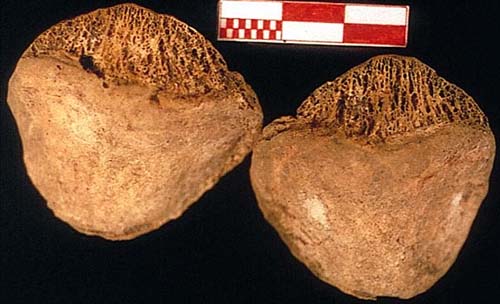
Diagnosis: Case 69 - Lesion on the internal distal face of both patella due to a kneeling position associated with pottery making.
Case 70
Specimen from the spine of a 20-year-old individual recovered during excavation at the site of a burial tomb in the Negev Desert of Israel. The tomb dates from the Roman period circa AD 100.
Submitted by Dr. Baruch Arensburg
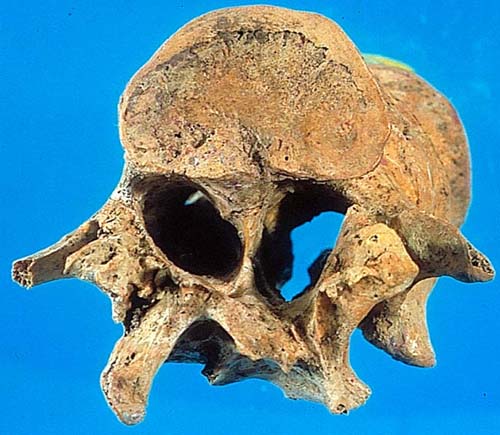
Diagnosis: Case 70 - Diastematomyelia of the Spinal Cord.
References: Edelson, J. G., Nathan, H., & Arensberg, B. (1987). Diastematomyelia: The double-barreled spine. Journal of Bone and Joint Surgery, 69, 8, p. 188.
Case 71
Fecal sample from a 34-year-old female who died 2,500 years ago in Northern Chile. Test with fluorescent monoclonal antibodies.
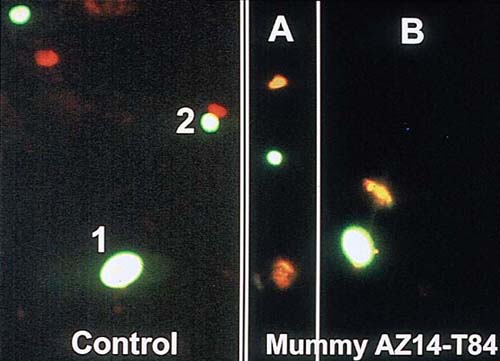
Diagnosis: Case 71 - Cryptosporidium parvum (A) and Giardia lamblia (B).
Case 72
The specimen is from an adult male. His grave dates back to the 14th-15th centuries. The right femur presents, at the distal epiphysis, a well defined incision partially delimiting a depressed area.
Submitted by Dr. E. Fulcheri and Dr. R. Boano

Diagnosis: Case 72 - Osteochondritis Dissecans in the necrotic phase.
Case 73
Ferrante I of Aragon, King of Naples died in 1494 at the age of 63. The autopsy evidenced in the small pelvis a fragment of hollow fibrous tissue, probably the rectum.
Submitted by Dr. Gino Fornaciari
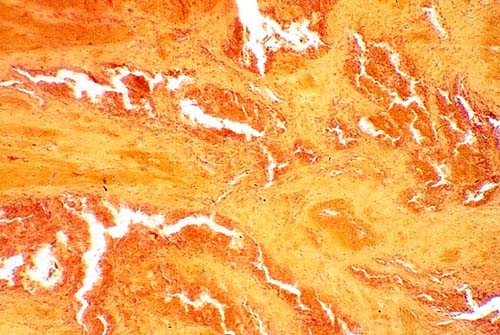
Diagnosis: Case 73 - Tumor of rectum.
Reference: Marchetti, M., Pelligrini, S., Bevilacqua, G., & Fornaciari, G. (1996). K-ras mutation in the tumor of Ferrante I de Aragon, King of Naples. The Lancet, 347, p.1272.
Case 74
Biopsy of the left arm ulcer from Maria d' Aragona, Marquise of Vasto (1503-1568).
Submitted by Dr. Gino Fornaciari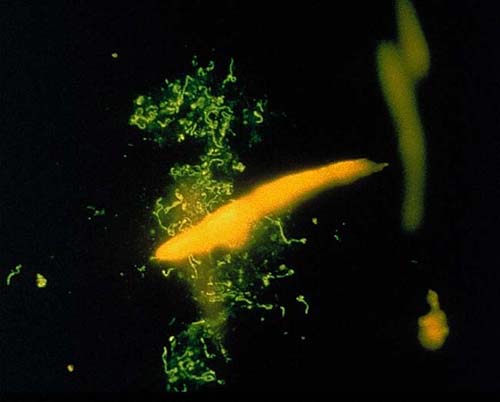
Diagnosis: Case 74 - Syphilis.
Case 75
Section of the rectum from a mummy of a middle-aged male dating to ca. 300 AD from Dakhleh Oasis in Middle Egypt.
Submitted by Dr. Michael R. Zimmerman
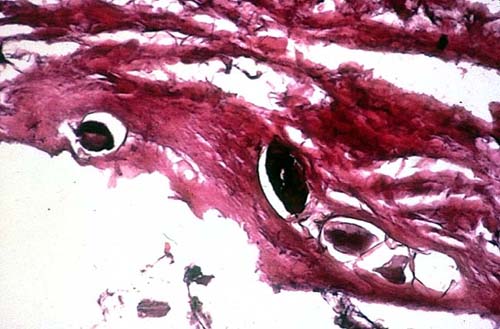
Diagnosis: Case 75 - Schistosomiasis.
Case 76
Adult female from pre-historic Lomas, Peru. Image shows right tibia and fibula (anterior), and right femur (posterior).
Submitted by Rose Tyson
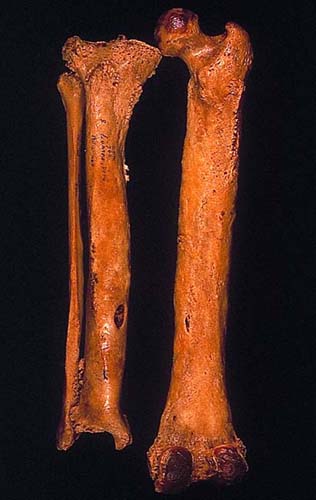
Diagnosis: Case 76 - Osteomyelitis of femur, tibia and fibula.
Case 77
Adult prehistoric female from Chilca, Peru. Image shows the sacro-iliac region.
Submitted by Rose Tyson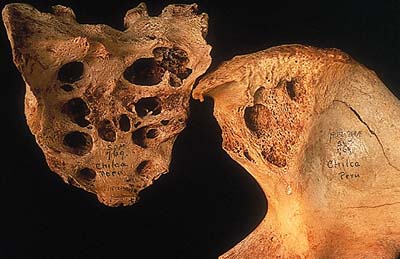
Diagnosis: Case 77 - Tuberculosis.
Case 78
Skull of undetermined sex--14th-15th century. The skull presents a post-mortem fracture that exposes the ethmoidal sinus in which was seen a little pedunculated lesion, 0.8 cm in its greatest diameter.
Submitted by E. Fulcheri, L. Ferrari, S. Boccone & R. Boano
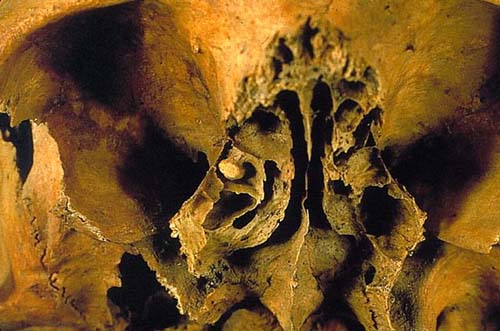
Diagnosis: Case 78 - Chronic rhinosinusitis.
Case 79
The image shows the sternum of a female 35-39-years-old who died 800 BP in the Columbian Andes.
Submitted by Dr. Felipe Cardenas-Arroyo
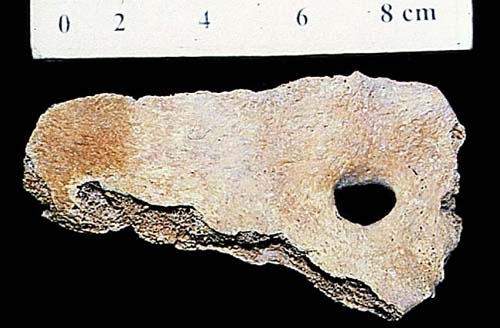
Diagnosis: Case 79 - Congenital anomaly of the sternum.
Case 80
The gross (above) and X-ray (below) are from the Pueblo culture before the European invasion (1300-1450). They represent an infant's thoracic skeleton several weeks of age, found in place in a grave dug in the floor of a room in a Pueblo dwelling.
Submitted by Dr. C. F. Merbs
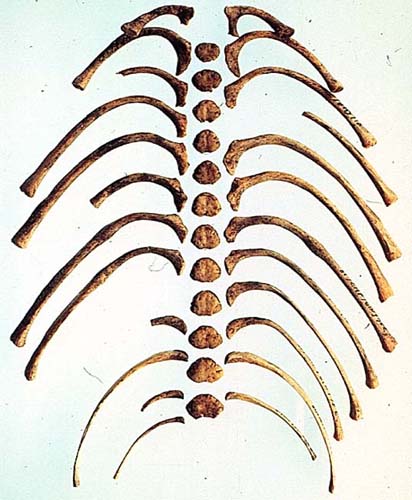
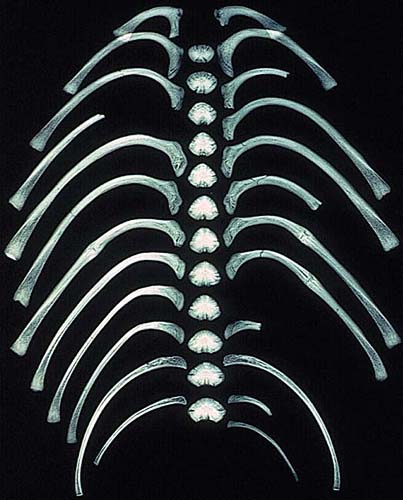
Diagnosis: Case 80 - Birth trauma.
Case 81
X-ray from a 30-year-old female who died 350 years ago.
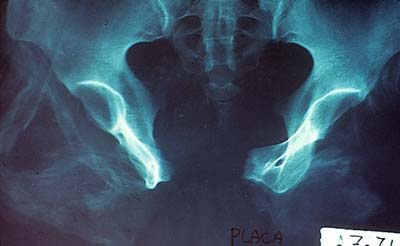
Diagnosis: Case 81- Recently delivered a child.
Case 82
Adult female from 4th century Spain with alteration of the posterior surface of L3 and L4 vertebrae.
Submitted by Dr. Campillo
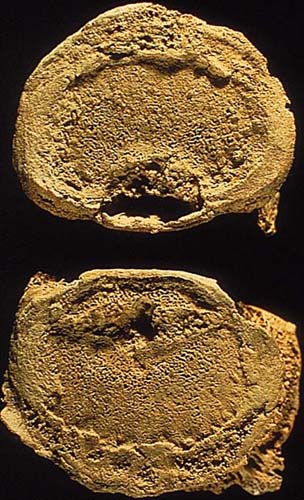
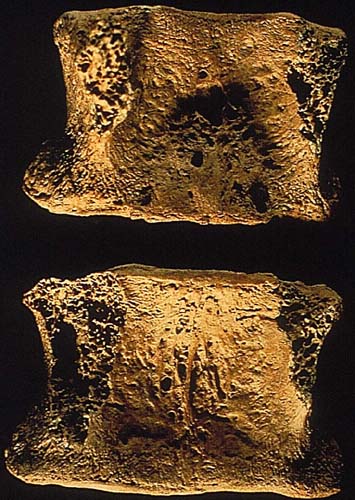
Diagnosis: Case 82 - Disc herniation with protrusion into the spinal canal.
Case 83
This image shows an H&E section from an eight-year-old girl. She was excavated from a Huari Gallery Burial in rural Nazca, Peru. She died about 1,200 years ago and was accompanied in death by 11 adults buried in a replica of a mountain house.
Among the dead in the house were thrown a beheaded man, woman and two children to serve the ceremonial dead. These were probably taken as prisoners since they were not ceremonial burials. The mummies were wrapped with many pounds of cotton and an outer cloth. The bundles had a false head, and some had masks.
The young girl's liver was one of 40 used in a viral hepatitis study in pre-Columbian mummies. The H&E section shows numerous tunnels in the liver. The material in the image was found in several tunnels.
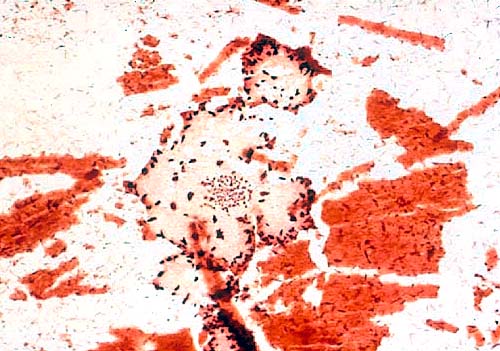
Diagnosis: Case 83 - Necrotic liver fluke.
Case 84
This image shows an inferior view of a maxilla (palatine and alveolar process) from a fragmented and incomplete skeleton.
Submitted by Fulcher, E., Boano, R., and Panto, G.
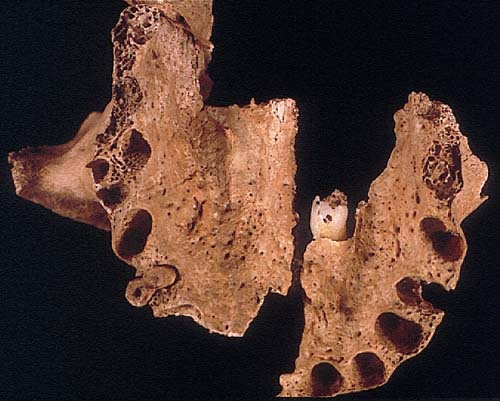
Diagnosis: Case 84 - Ectopic tooth.
Paleopathology Cases 84-130
Case 130
Autopsy finding in a mummy of ancient Peru (young girl).
Submitted by: Dr. Enrique Gerszten, Virginia Commonwealth University, Medical College of Virginia, Richmond, VA.

Diagnosis: Skull of a young girl with a large left parietal fracture resulting in a massive subdural hemorrhage.
Case 131
Skull from a 12-year-old boy from an excavation from Northern Chile (AD 1100).
Submitted by: Dr. Enrique Gerszten, Virginia Commonwealth University, Medical College of Virginia, Richmond, VA.

Diagnosis: Biparietal porotic hyperostosis resulting from chronic anemia in a 12-year-old boy of the regional culture (AD 1100).
Case 132
Lungs from a Native American from an excavation found in Southern Peru (AD 1600).
Submitted by: Dr. Enrique Gerszten, Virginia Commonwealth University, Medical College of Virginia, Richmond, VA.

Diagnosis: The lungs show severe anthracosis from a Native South American working in a mine.
Case 133
The slide is from a male captive from the Pyramid of the Moon, Moche River Valley, Northern Peru, excavated from an Archeological site.
Submitted by: Dr. John Verano, Tulane University, New Orleans, LA.

Diagnosis: The slide shows shallow cut marks from slitting of the throat (yellow arrows) and deeper cuts, probably from decapitation of the victim.
Case 134
Skull from an excavation in Peru from the Nazca culture. The surgical technique for trephination in the skull was called crosscut and it was done following a trauma to the skull.
Submitted by Dr. Enrique Gerszten, Virginia Commonwealth University, Medical College of Virginia, Richmond, VA.

Diagnosis: Severe periostitis following a trephination of the skull.
Case 135
Endoscopic image from the interior of the cardiac cavity of a mummy of the region of Chiu-Chiu, Chile.
Submitted by Drs. Jodi Esteban and Pedro L. Fernández, Depto. Anatomia Patologica, University of Barcelona, Spain.

Diagnosis: The image shows necrophagous insects belonging to the order of coleoptera (family: dermestidae).
Case 136
Internal abdominal organ from a mummy from Northern Chile.
Submitted by Dr. Enrique Gerszten, Virginia Commonwealth University, Medical College of Virginia, Richmond, VA.

Diagnosis: Spleen
Case 137
Remains of a 32-year-old woman from the Inca period (AD 1500). The lesion involves T9 through T12 with complete destruction of the vertebral bodies of T10 and T11. There is some evidence of bony fusion.
Submitted by Dr. Peter C. Gerszten, University of Pittsburgh, Pittsburgh, PA.

Diagnosis: Healed Pott’s disease.
Case 138
Endoscopy of internal thoracic wall of male mummy. Location: Chiu-Chiu region (Chile). (AD VI).
Submitted by Agustín Franco, Dept. of Urology, Hospital Clinic, Barcelona; Jordi Esteban, Dept. of Pathology, Hospital Clinic, Barcelona; José Antonio Sanchez, Sc

Diagnosis: Pleural adhesions.
Case 139
Slide shows a microscopic finding in the kidney of a South American mummy.
Submitted by Dr. Enrique Gerszten, Virginia Commonwealth University, Medical College of Virginia, Richmond, VA.

Diagnosis: Blood vessel.
Case 140
Pre-Columbian adult mummy from Northern Chile (AZ 71-T57). Organ from the thorax.
Submitted by Dr. Enrique Gerszten, Virginia Commonwealth University, Medical College of Virginia, Richmond, VA.

Diagnosis: Heart.
Case 141
Skin: (Left) Right pretibial region. Young adult male, Chimu culture (Late Intermediate Period, ca. 1100-1400 AD); (Right) Microscopic picture of the skin.
Submitted by Jordi Esteban, MD and Pedro L. Fernandez, MD, PhD, from Dept. of Pathology, Hospital Clínic of Barcelona and University of Barcelona.
.jpg)
Diagnosis: Tattoo: Black pigment in deep dermis.
Case 142
Skeletal lesion from a Roman period Burial. Distal femoral joint surface and patella.
Submitted by Dr. Robert R. Paine from Texas Tech University, Lubbock, TX.

Diagnosis: Femoral joint. Degenerative joint disease.
Case 143
X-rays shows a lesion in a 30-year-old female mummy from Northern Chile.
Submitted by Alexander N. Gabrovsky, Virginia Commonwealth University, Medical College of Virginia, Richmond, VA.

Diagnosis: Calcification in the Abdominal Aorta.
Case 144
The figure shows the inferior view of right medial clavicle, with a well-developed rhomboid fossae. Specimen found in excavation from Bouqras, Syria, ca. 8800 BP in a desert area with known exposure to the grass pea toxins.
Submitted by Dr. Deborah C. Merrett from Simon Fraser University, Burnaby, British Columbia, Canada.

Diagnosis: Inferior view of right medial clavicle, showing a well-developed rhomboid fossae. Possible lathyrism.
Case 145
The slide shows the face of a priest from the early XVII Century entombed in the basement of the Church “Iglesia del Carmen” in Mexico City.
Submitted by Dr. Enrique Gerszten, Virginia Commonwealth University, Medical College of Virginia, Richmond, VA.

Diagnosis: Smallpox. We don’t know exactly when the disease killed the priest shown in the slide, we suspect that he died some time in the eighteenth century.
Case 146
Subcutaneous mass on the right side of the chest from a male aged 14 of Northern Chile from 1,100 to 1,200 AD.
Submitted by Dr. Enrique Gerszten, Virginia Commonwealth University, Richmond, Virginia.

Diagnosis: Lipoma. The histology shows conglomeration of fat cells intermingling with fibrous septa.
Case 147
Femur bones of 13th century female aged 45-55 years at time of death, Poggibonsi, Siena, Italy.
Submitted by Dr. Valentina Giuffra, University of Pisa, Italy.

Diagnosis: Greenstick fracture, probably occured during the infantile age (absence of a true callus).
Current Case 148
Skull from Chanka Culture, Andahuaylas, Peru (ca. AD 1150-1250).
Submitted by Danielle S. Kurin, University of California, Santa Barbara, CA.

Diagnosis: Artificial Cranial deformation